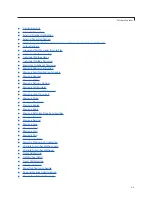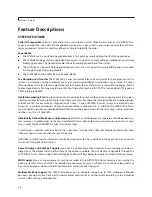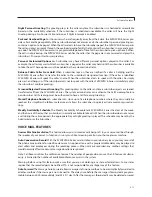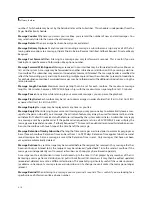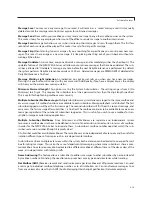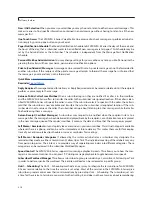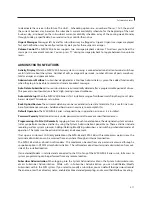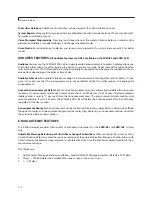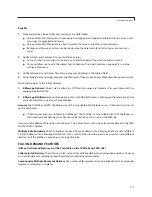
Message Save
You may save any message. Once saved, it will remain as a 'saved' message until it is manually
deleted or until the message retention timer expires for unlistened messages.
Message Send
From within your mailbox you may send a message to any other mailbox owner on the system.
This makes it easy for any employee who is out of the office to send a message to another internal user.
Message Scan
Message Scan allows a user who is retrieving their messages to 'scan' through them. The first few
seconds of each message will be played. This makes it easy to find a specific message.
Message Skip
When listening to new messages, if you a searching for a specific one you can skip over new mes-
sages. This saves the message as a new message. It is like picking one thing out of your in-basket without dis-
turbing all the others.
Message Undelete
At some time, everyone discards a message, and immediately wishes they had kept it. The
undelete feature of the SVM/SVMi E-Series will allow you to retrieve messages that have been deleted. The sub-
scriber is allowed to "Undelete" a message any time before the next Daily Maintenance is performed. By default
the system performs Daily Maintenance everyday at 3:00 am. Deleted messages are PERMANENTLY deleted after
Daily Maintenance is finished.
Message Waiting Light Indication
An indication on your keyset tells you when you have new messages.
Pressing this one button will connect with your voice mail. Additionally, if you have a display keyset, the display
will show you the current new message status.
Minimum Password Length
This option is set by the System Administrator. The setting range is from 0 (No
Minimum) to 8 Digits. This requires the subscriber to set their password to less then the digit length specified.
This is useful for heightening mailbox access security.
Multiple Subscriber Mailboxes Login
Multiple subscribers may simultaneously logon to the same mailbox and
access messages. All mailbox functions are available to each subscriber. Message playback is distributed. The first
subscriber logged on will hear the first message. The second subscriber will first hear the second message, and
can access the first message after subscriber 1 is finished. The mailbox continues to be available to receive new
messages, regardless of the number of subscribers logged on. This is useful if you wish to use a mailbox for tran-
scription storage or order taking applications.
Multiple Subscriber Mailboxes
Since Extensions and Mailboxes are separate and independent system
resources, a mailbox does not have to be defined in terms of an extension, or an extension in terms of a mailbox,
in order for the SVM/SVMi E-Series to associate them. A subscriber's mailbox number need not match the sub-
scriber's extension number (though it typically does).
A Subscriber could have multiple mailboxes. These mailboxes can be independent of extensions and be useful for
isolation different types of messages such as in a departmental mailbox.
A subscriber can have multiple extensions within the system. Each extension can be directed to one specific mail-
box for taking messages. This is also the case of departmental messaging where many subscribers share a com-
mon mailbox. An extension may also be directed to a different mailbox at different times of the day or days of the
week, as in departments with rotating staffs.
Name Addressing
This feature allows a subscriber to address messages to other subscribers by name instead of
by mailbox number, eliminating the need to look up numbers or carry personal directories while traveling.
Net Mailbox (AMIS)
Receives, records and, sends voice messages to mailboxes at off-premise locations. Can send
a message to individual mailbox/telephone number, or to a Distribution List. Can send/receive messages to or
from any voicemail system that is AMIS (Audio Messaging Interchange Specification) Network compliant.
3.15
Software Features



